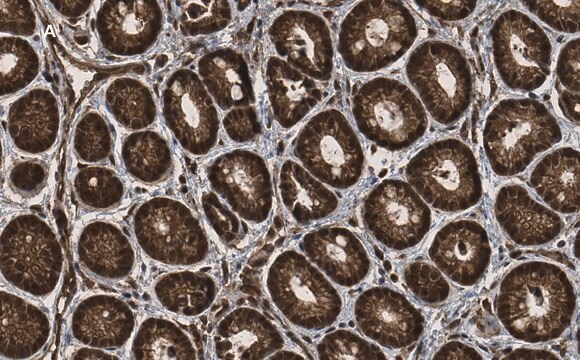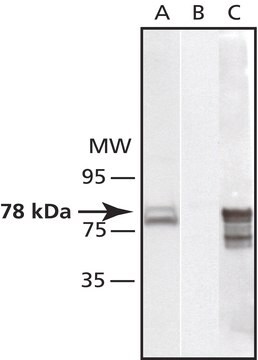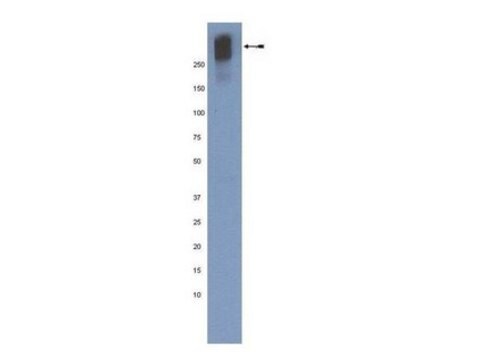추천 제품
생물학적 소스
rabbit
Quality Level
항체 형태
affinity isolated antibody
항체 생산 유형
primary antibodies
클론
polyclonal
정제법
affinity chromatography
종 반응성
mouse, hamster, human, monkey, rat
제조업체/상표
Chemicon®
기술
immunocytochemistry: suitable
immunofluorescence: suitable
immunohistochemistry: suitable
immunoprecipitation (IP): suitable
western blot: suitable
NCBI 수납 번호
UniProt 수납 번호
배송 상태
wet ice
타겟 번역 후 변형
unmodified
유전자 정보
human ... ITPR2(3709)
특이성
Rabbit anti-Type II Inositol 1,4,5-Trisphosphate Receptor (IP3R) is directed against a synthetic peptide corresponding to the carboxy terminus of the rat Type II receptor. The antibody is reactive with Type II IP3R from rat, mouse, human, hamster, and monkey.
면역원
Synthetic peptide corresponding to the carboxy terminus of the rat Type II receptor
애플리케이션
Anti-IP3 Receptor Type II Antibody detects level of IP3 Receptor Type II & has been published & validated for use in IC, IF, IH, IP & WB.
Research Category
Signaling
Signaling
Research Sub Category
GPCR, cAMP/cGMP & Calcium Signaling
GPCR, cAMP/cGMP & Calcium Signaling
Western blot: 1:50 - 1:100 (detects a 260 kDa band)
Immunofluorescence: 1:10 - 1:20
Immunoprecipitation
Immunocytochemistry: Known to give positive reactivity on AR4-2J, HL-60, COS-I, HEK-293, and RBL-2H3 cell lines.
Immunohistochemistry: Paraformaldehyde or methanol fixes are effective.
Optimal working dilutions must be determined by end user.
Immunofluorescence: 1:10 - 1:20
Immunoprecipitation
Immunocytochemistry: Known to give positive reactivity on AR4-2J, HL-60, COS-I, HEK-293, and RBL-2H3 cell lines.
Immunohistochemistry: Paraformaldehyde or methanol fixes are effective.
Optimal working dilutions must be determined by end user.
물리적 형태
Affinity purified versus immobilized immunogen peptide. Liquid in PBS buffer, containing 0.05% BSA, 10% glycerol, 0.005% sodium azide. Caution: Sodium azide is hazardous. MSDS available upon request.
저장 및 안정성
Maintain frozen at -20°C in undiluted aliquots for up to 12 months.
법적 정보
CHEMICON is a registered trademark of Merck KGaA, Darmstadt, Germany
면책조항
Unless otherwise stated in our catalog or other company documentation accompanying the product(s), our products are intended for research use only and are not to be used for any other purpose, which includes but is not limited to, unauthorized commercial uses, in vitro diagnostic uses, ex vivo or in vivo therapeutic uses or any type of consumption or application to humans or animals.
적합한 제품을 찾을 수 없으신가요?
당사의 제품 선택기 도구.을(를) 시도해 보세요.
Storage Class Code
10 - Combustible liquids
WGK
WGK 2
시험 성적서(COA)
제품의 로트/배치 번호를 입력하여 시험 성적서(COA)을 검색하십시오. 로트 및 배치 번호는 제품 라벨에 있는 ‘로트’ 또는 ‘배치’라는 용어 뒤에서 찾을 수 있습니다.
Bcl-2 functionally interacts with inositol 1,4,5-trisphosphate receptors to regulate calcium release from the ER in response to inositol 1,4,5-trisphosphate.
Chen, R; Valencia, I; Zhong, F; McColl, KS; Roderick, HL; Bootman, MD; Berridge et al.
The Journal of cell biology null
Mark Chalmers et al.
The Biochemical journal, 394(Pt 1), 57-66 (2005-11-09)
The size and number of IP3R (inositol 1,4,5-trisphosphate receptor) clusters located on the surface of the ER (endoplasmic reticulum) is hypothesized to regulate the propagation of Ca2+ waves in cells, but the mechanisms by which the receptors cluster are not
Type I, II, and III inositol 1,4,5-trisphosphate receptors are unequally susceptible to down-regulation and are expressed in markedly different proportions in different cell types.
Wojcikiewicz, R J
The Journal of Biological Chemistry, 270, 11678-11683 (1995)
D I Yule et al.
The Journal of biological chemistry, 272(14), 9093-9098 (1997-04-04)
A key event leading to exocytosis of pancreatic acinar cell zymogen granules is the inositol 1,4,5-trisphosphate (InsP3)-mediated release of Ca2+ from intracellular stores. Studies using digital imaging microscopy and laser-scanning confocal microscopy have indicated that the initial release of Ca2+
Takahiro Fujimoto et al.
International journal of molecular medicine, 30(6), 1287-1293 (2012-09-21)
KRAS-induced actin-interacting protein (KRAP), originally identified as one of the deregulated genes expressed in colorectal cancer, participates under physiological conditions in the regulation of systemic energy homeostasis and of the exocrine system. We have recently found that KRAP is a
자사의 과학자팀은 생명 과학, 재료 과학, 화학 합성, 크로마토그래피, 분석 및 기타 많은 영역을 포함한 모든 과학 분야에 경험이 있습니다..
고객지원팀으로 연락바랍니다.





